
By James Maxon and Gary B. Tinagero
On July 29, 2017, the Sandoval County (NM) Fire Department (SCFD) was dispatched to the collapse of a rock and gravel pit at Vulcan Materials in Bernalillo, New Mexico, with trapped patients. The company is the nation’s largest producer of construction aggregates—primarily crushed stone, sand, and gravel—and a major producer of aggregates-based construction materials including asphalt and ready-mixed concrete.1
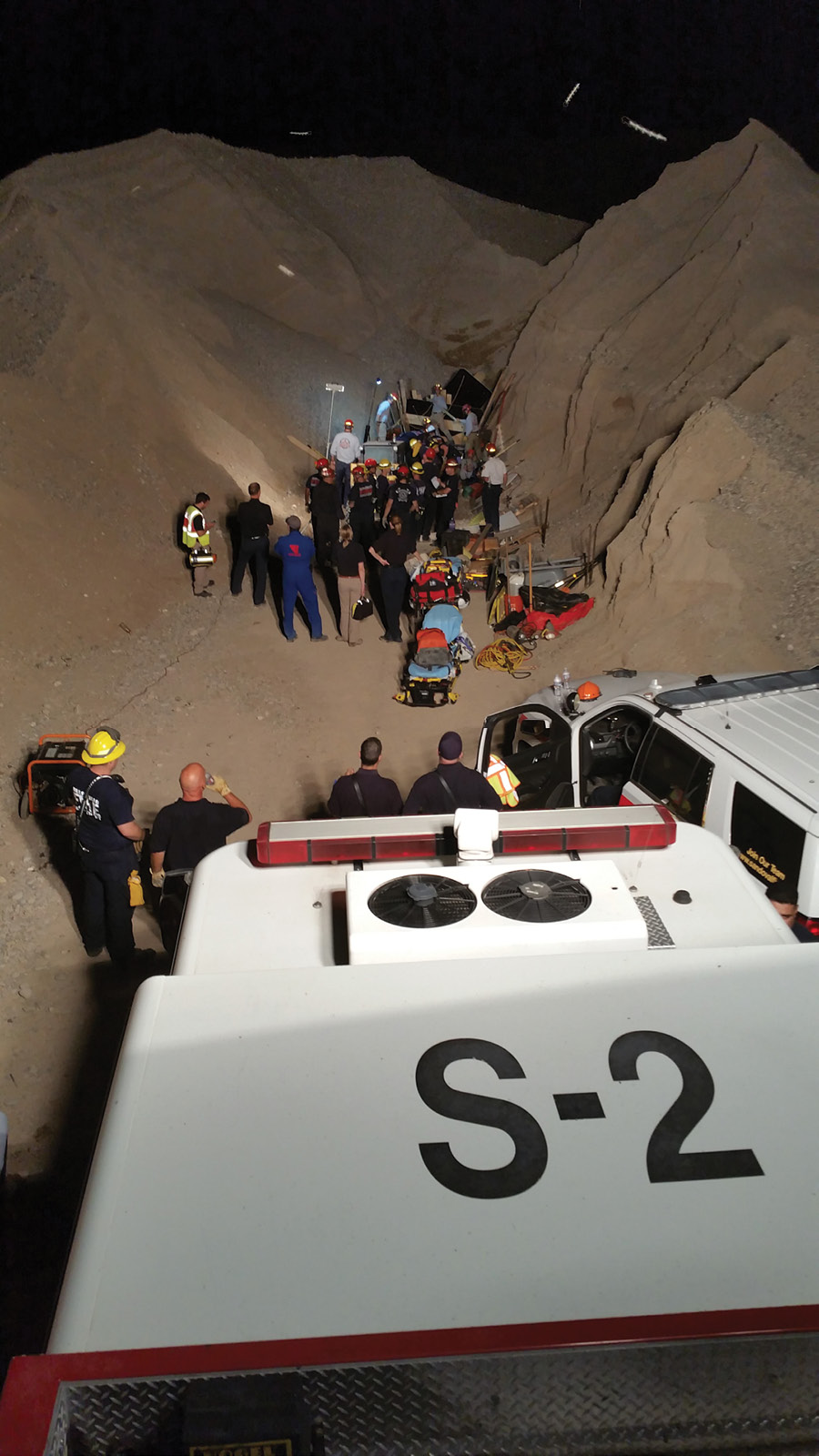
(1) Nighttime operations during the fourth hour of the operation. (Photo by James Maxon.)
The Emergency
Workers at the plant were attempting to free gravity-fed rock aggregate from a pile that normally sifted down to a below-grade underground conveyer system. The surrounding sand and gravel mix suddenly gave way, and one person was initially engulfed. Other workers in the area tried to free him; they became trapped by secondary collapses. The sudden chain of events resulted in four individuals being dangerously entrapped. Two patients were buried up to their necks, one up to the chest, and the other up to the waist. The adjacent dirt, rock, and gravel pile was 40 feet high on three sides of the trapped workers and had a steep 60° to 75° angle of repose.
The initial dispatch at 1703 hours consisted of two ambulances, one engine, a shift commander, and the Sandoval County fire chief. The Regional Rio Grande Basin Technical Rescue Team (TRT) was also requested immediately after the initial dispatch. Chief James Maxon arrived on the scene first. The plant was so large that he threw out traffic vests at every turn to leave a physical trail to help additional arriving responders navigate the unmarked roads to the scene.
Initial Actions
On Maxon’s arrival at the gravel plant, workers advised him that four workers were buried over their heads. This information was radioed to responding units. Maxon assumed command and proceeded to the rescue area in the mega-acre rock/gravel facility. The plant had no specialty rescue equipment available.
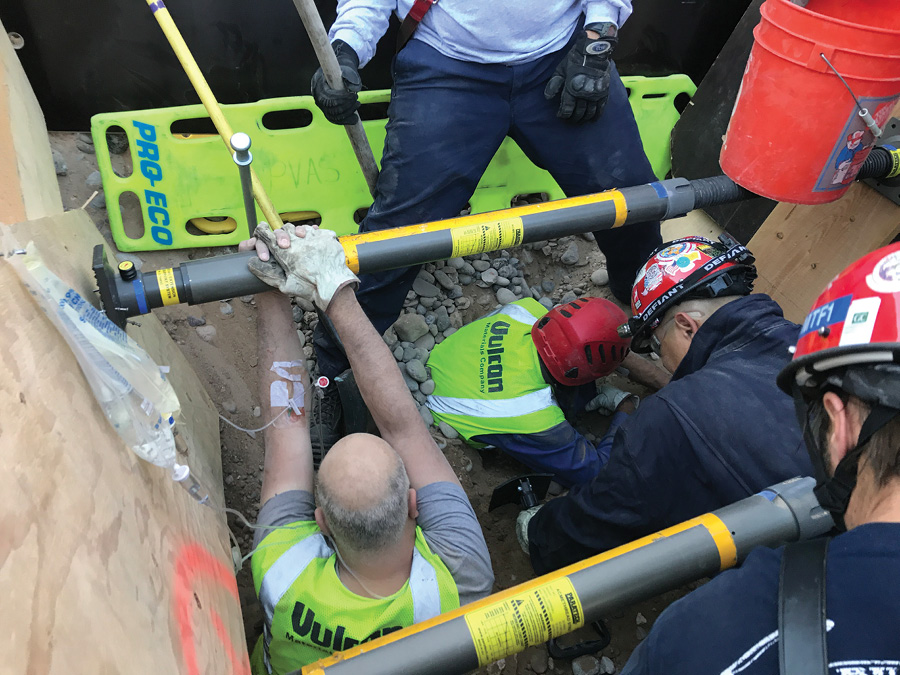
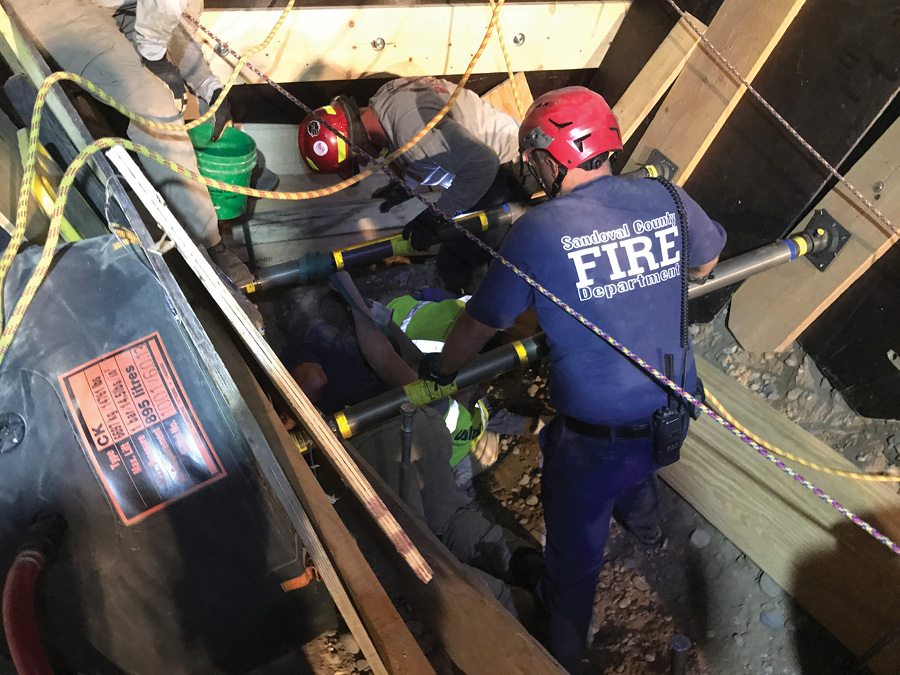
(2-3) Crews work to free patients 3 and 4 who had been buried up to their necks. (Photos by Jake Bailey, Rio Rancho Fire and Rescue.)
Maxon checked the patients and determined they were not buried over their heads and had patent airways. The initial plan was to stabilize the patients and try to keep falling rocks and dirt off them. Backboards were used to shield the trapped patients from additional falling debris. The employees from the gravel mine were initially used to help rescuers because of their technical knowledge and because they wanted to help their colleagues. Once enough fire service rescuers were on scene, the employees were taken out of the hot zone. Additional collapse was a major concern; small sporadic slides were showering the patients and Maxon with rock and dirt. Medic 43 arrived and took over patient care.
The situation was high risk; rescuers and patients were in critical danger for six hours. The risk vs. benefit ratio with four lives at stake justified the risk to the rescuers. A unified command was set up with the three law enforcement agencies: the Santa Ana Pueblo Tribal Police, the Sandoval County Sheriff’s Office, and the Town of Bernalillo Police.
Incident Commander (IC) Maxon backed out of the hot zone when other personnel arrived so that he could keep a good vantage point on the rock slides and establish a personnel accountability system. Since there was an extended extrication time, SCFD Deputy Chief Eric Masterson requested three helicopters for the immediate transport of the patients to the local trauma center. SCFD Chief 4 Humberto Macias established a landing zone and handled all helicopter landings. Medic 43 and Medic 21 treated the patients with oxygen and provided them with protective helmets. The Albuquerque (NM) Fire Department (AFD) Heavy TRT was requested because of the need for significant shoring and their technical rescue skills.
Safety was paramount considering the victims and rescue personnel were in immediate danger working in the hazard zone. Command assigned SCFD Scott Kelly from Medic 43 as the initial safety officer. Rio Rancho (NM) Fire Department (RRFD) Battalion Chief Dave Patterson became Operations chief. Physicians requested from the University of New Mexico Emergency Medical Services Consortium arrived.
Rescue Operations
Rescue operations were started in an offensive strategy because of the four viable patients. All units were advised that they were in rescue mode. A brief risk vs. benefit analysis came down to life safety. The fire service preaches “risk a lot to save a life.” Four trapped workers needed assistance; this was clearly defined as an acceptable risk to rescuers. Squad 9 from the Corrales (NM) Fire Department (CFD) arrived at 1743 hours as part of the Rio Grande Basin TRT and conducted an initial size-up. The decision was to proceed as for a trench collapse rescue. Fin forms, captured with aluminum pneumatic struts, were placed to protect the work area where the victims were. The sloped shape of the work area presented some exterior void challenges when placing the protective panels. The technical rescue crews began digging a channel into the slope to place the protective system and used low-pressure air bags to fill in the area behind the panels and square them up as much as possible before pressurizing the pneumatic struts.
The work area was in live soil with very little cohesiveness. Crews dug with shovels and by hand to free the workers. The first patient was extricated at 1753 hours, 50 minutes into the incident. The live soil was moving extremely slowly but enough to keep the piles active and continuously feeding soil into the hot zone underneath the fin forms and through the corners of the protected area.
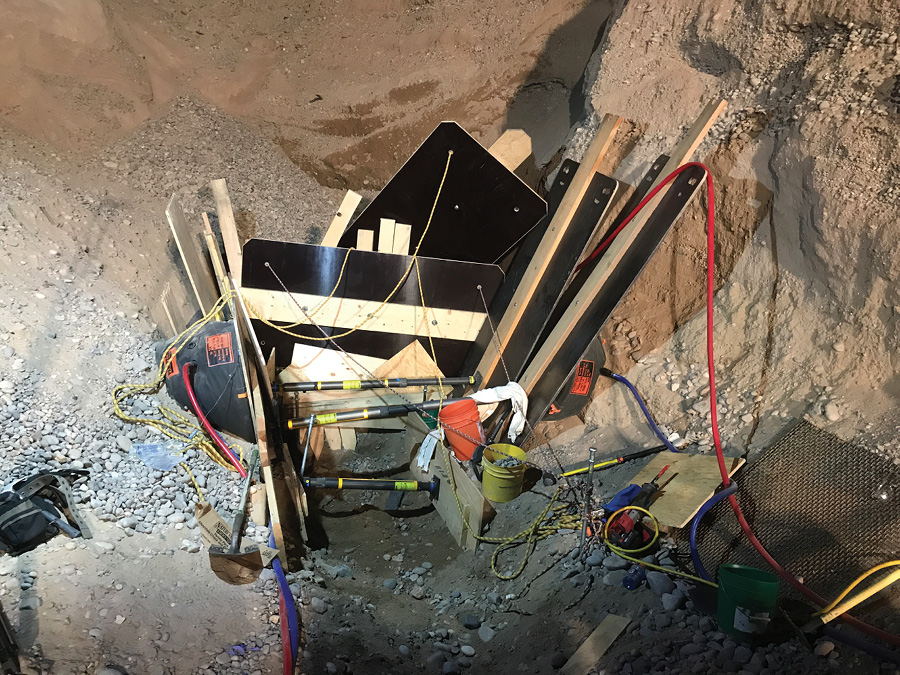
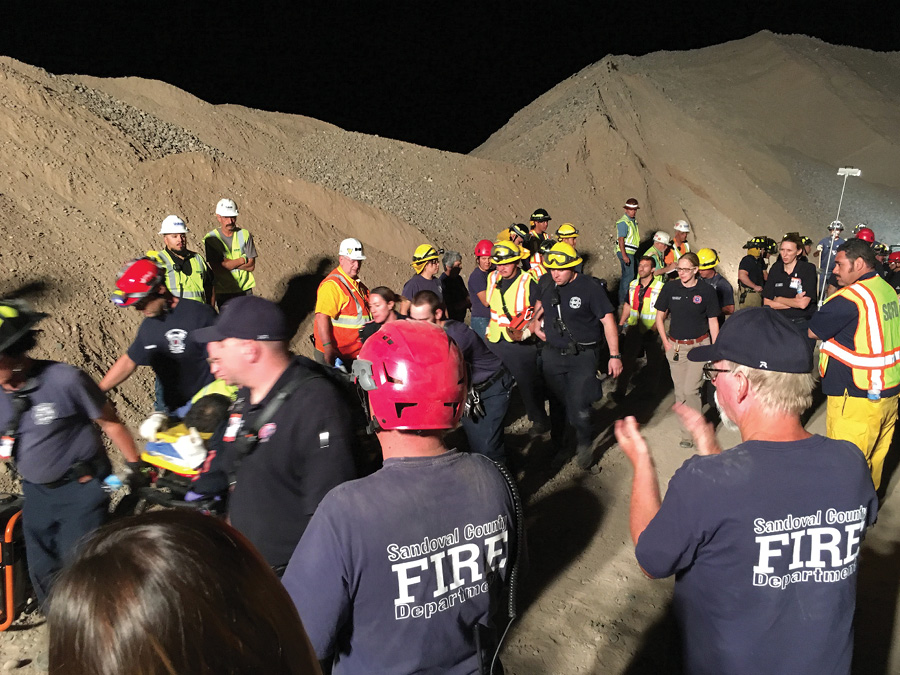
(4) The framework constructed for the final rescue. (5) The last trapped worker is freed. (Photos by James Maxon.)
For safety reasons, the number of rescue personnel in the hazard zone was limited to coordinated rescue teams of six personnel. This allowed the team to maintain patient care, advance the protective system, and continue digging. Small shovel teams moved the rock and dirt from around the patients. A three-person rapid intervention crew (RIC) was established. The RIC stood by with rope, shovels, and communications equipment. Collapse from the nearby piles was a constant threat. Rescue teams operated in the hot zone for 20-minute intervals and were rotated out. Relief teams were assembled and staged in the warm zone. A Rehabilitation Group provided food and hydration for the rescue teams.
The second patient was freed at 1853 hours and was transferred to Air EMS personnel on scene. The remaining two patients were found in proximity to each other. Digging was slow and done by hand or with small hand trowels.
The operation was moving from day to night, and the remaining patients were becoming fatigued as rescuers continued to work to save their lives. Physicians were brought into the hot zone to evaluate the patients’ condition and provide support. At this point, both patients were uncovered to their waist; only their legs remained trapped. As the teams continued to work, it was discovered that the calves of the patients extended outside the protective panels. Numerous times, the rescue teams uncovered the patients to below their knees only to have the area around them refill up to their waist. We considered a vacuum truck, but one was not available, and it would have been extremely difficult for it to gain access. Instead, the cut team cut 2 × 6s with beveled ends like a picket fence. The pickets were then taken into the protected area and fed from the inside to the outside of the fin forms, where they were slightly tapped into place vertically. This slowed the progress of the soil entering the protected area enough to enable rescuers to place protection below the fin forms and remove the soil and ultimately extricate the patients.
Incident Action Plan
The incident action plan (IAP) consisted of the following components:
- Establishing safety/hazard zones (hot/warm/cold).
- Establishing a perimeter to keep noninvolved individuals out of the immediate area.
- Conducting patient-removal operations.
- Implementing a Safety STOP. Rest personnel before returning to work. Conduct a safety briefing.
- Removing equipment used in the rescue operations.
- Demobilization.
- After-action review.
Tables 1 and 2, respectively, show the on-scene assignments and the victim removal times.
|
|
|
Incident Commander/ |
Chief James Maxon (SCFD) |
|
Support Officer/Incident Commander |
BC Gary Tinagero (AFD) |
|
Operations Officer |
BC Dave Patterson (RRFD) |
|
Extrication Group Supervisor |
Lt Chris Carlsen (AFD) |
|
Documentation Group |
Asst. Chief Carlos Chavez (SCFD), Lt Brian Fox (AFD) |
|
Safety Officers |
Dep Chief Eric Masterson (SCFD), FF Scott Kelley (SCFD) |
|
EMS Group |
Dr. Jenna White MD-10 (SCFD EMS Physician), Dr. Dan Shocket MD-9 (AFD) |
|
Security Group |
Santa Ana Pueblo Police Dept Gary Tafoya, Sandoval County Sheriff’s Dept. |
|
Rehabilitation/ |
Mike Scales (SCFD) |
|
Rescue Teams |
*SCFD, AFD, RRFD, BFD, and CFD |
*Sandoval County Fire Dept., Albuquerque Fire Dept., Rio Rancho Fire Dept., Bernalillo Fire Dept., and Corrales Fire Dept.
|
|
|
Victim 1 |
1753 hours (fourth person trapped) |
|
Victim 2 |
1853 hours (third person trapped) |
|
Victim 3 |
2237 hours (second person trapped) |
|
Victim 4 |
2305 hours (first person trapped) |
After-Action Review and Lessons Learned
A few areas were recognized as needing improvement after this stressful dynamic operation.
- There were no machinery operations at the time of the incident, but it became clear that we should have had fire personnel initiate the lock out/tag out on the conveyor system vs. using plant personnel.
- A public information officer should have been designated instead of switching the IC duties between two chief officers so that Maxon could brief the media.
- Hot/warm/cold zone markers should have been established with flagging or cones to deliniate the areas. It was difficult at times to keep rescue personnel from encroaching on the hazard zone. The professional nature of the troops was evident, and they wanted to make a difference in the progress of the rescue operation.
- It was difficult to keep the helicopter crews in the cold zone; these trained individuals also wanted to go to work! Helicopter radio/communication issues and training should be conducted more frequently.
- Consider shoring in the tunnel area below the entrapment (to where the gravel was fed) to prevent the movement of rock/gravel.
Operation Strengths
The following strengths of the operation were cited:
- The incident command system (ICS) works. Personnel from multiple juridictions were able to come together and work in strategic-, tactical-, and task-level positions with seamless effort. Implemention and continuous use of the ICS led the way.
- An IAP drove the operational objectives in a safe and effective manner (strong leadership by assigned officers also contributed here).
- There were good tactical adjustments by the Operations chief, the Extrication Group supervisor, and Rescue Team supervisors.
- As the evening progressed, an effective lighting system was created for the rescue and staging areas.
- Since this was such a large facility, there was adequate space for helicopter landing zones and an effective restriction of air space over the operation area. There were local media concerns since the trapped workers’ names had not been released.
- The Medical Group provided continuous patient assessment and expert care.
Operation Outcome
Eighty-seven personnel from local and mutual-aid jurisdictions participated in the removal of four trapped victims during the six-hour operation. All patients were transported to the University of New Mexico Hospital in Albuquerque. All survived.
Reference
1. Vulcan Materials Company. (2013). Retrieved from https://www.vulcanmaterials.com/about-vulcan on July 23, 2017.
James Maxon, MPA, EFO, CFO, is a 26-year veteran of the fire service and the chief for the Sandoval County (NM) Fire Department. He began his career with the Hondo Volunteer Fire Department in Santa Fe County in 1992. He previously served in the U.S. Air Force as a firefighter on Kirtland Air Force Base and with the New Mexico State Fire Marshal’s Office as a senior fire inspector/investigator. He was named the New Mexico Fire Officer of the Year in 2012. He is a member of the IAFC Program Planning Committee and Elections Committee and is an IAFC representative on the ICC Fire Service Membership Council Governing Committee. He is co-chair of the Albuquerque Metro Fire Chiefs Association and is the chair for the Board of Trustees for the New Mexico Public Employees Retirement Association.
Gary B. Tinagero, MS, EFO, CFO, is a battalion chief (retired 2018) and a 27-year veteran of the Albuquerque Fire Department (NM), where he served as Battalion 2. He has been a Fire Engineering contributor. He has a master’s degree in executive fire service leadership and is a shift operations coordinator of emergency management at a national laboratory.

